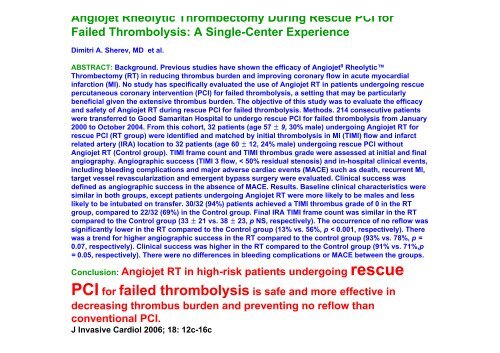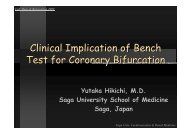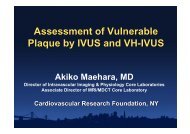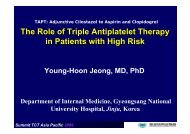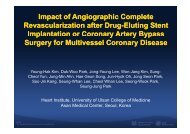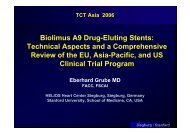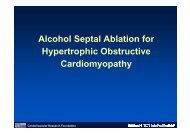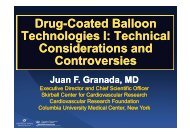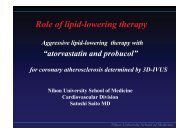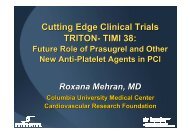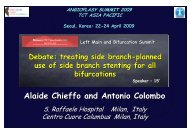On Topaz MD, FACC, FSVM - summitMD.com
On Topaz MD, FACC, FSVM - summitMD.com
On Topaz MD, FACC, FSVM - summitMD.com
Create successful ePaper yourself
Turn your PDF publications into a flip-book with our unique Google optimized e-Paper software.
Angiojet Rheolytic Thrombectomy During Rescue PCI for<br />
Failed Thrombolysis: A Single-Center Experience<br />
Dimitri A. Sherev, <strong>MD</strong> et al.<br />
ABSTRACT: Background. Previous studies have shown the efficacy of Angiojet 9 Rheolytic<br />
Thrombectomy (RT) in reducing thrombus burden and improving coronary flow in acute myocardial<br />
infarction (MI). No study has specifically evaluated the use of Angiojet RT in patients undergoing rescue<br />
percutaneous coronary intervention (PCI) for failed thrombolysis, a setting that may be particularly<br />
beneficial given the extensive thrombus burden. The objective of this study was to evaluate the efficacy<br />
and safety of Angiojet RT during rescue PCI for failed thrombolysis. Methods. 214 consecutive patients<br />
were transferred to Good Samaritan Hospital to undergo rescue PCI for failed thrombolysis from January<br />
2000 to October 2004. From this cohort, 32 patients (age 57 ± 9, 30% male) undergoing Angiojet RT for<br />
rescue PCI (RT group) were identified and matched by initial thrombolysis in MI (TIMI) flow and infarct<br />
related artery (IRA) location to 32 patients (age 60 ± 12, 24% male) undergoing rescue PCI without<br />
Angiojet RT (Control group). TIMI frame count and TIMI thrombus grade were assessed at initial and final<br />
angiography. Angiographic success (TIMI 3 flow, < 50% residual stenosis) and in-hospital clinical events,<br />
including bleeding <strong>com</strong>plications and major adverse cardiac events (MACE) such as death, recurrent MI,<br />
target vessel revascularization and emergent bypass surgery were evaluated. Clinical success was<br />
defined as angiographic success in the absence of MACE. Results. Baseline clinical characteristics were<br />
similar in both groups, except patients undergoing Angiojet RT were more likely to be males and less<br />
likely to be intubated on transfer. 30/32 (94%) patients achieved a TIMI thrombus grade of 0 in the RT<br />
group, <strong>com</strong>pared to 22/32 (69%) in the Control group. Final IRA TIMI frame count was similar in the RT<br />
<strong>com</strong>pared to the Control group (33 ± 21 vs. 38 ± 23, p NS, respectively). The occurrence of no reflow was<br />
significantly lower in the RT <strong>com</strong>pared to the Control group (13% vs. 56%, p < 0.001, respectively). There<br />
was a trend for higher angiographic success in the RT <strong>com</strong>pared to the control group (93% vs. 78%, p =<br />
0.07, respectively). Clinical success was higher in the RT <strong>com</strong>pared to the Control group (91% vs. 71%,p<br />
= 0.05, respectively). There were no differences in bleeding <strong>com</strong>plications or MACE between the groups.<br />
Conclusion: Angiojet RT in high-risk patients undergoing rescue<br />
PCI for failed thrombolysis is safe and more effective in<br />
decreasing thrombus burden and preventing no reflow than<br />
conventional PCI.<br />
J Invasive Cardiol 2006; 18: 12c-16c


